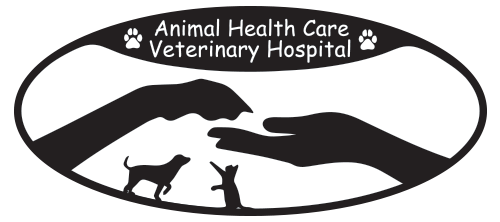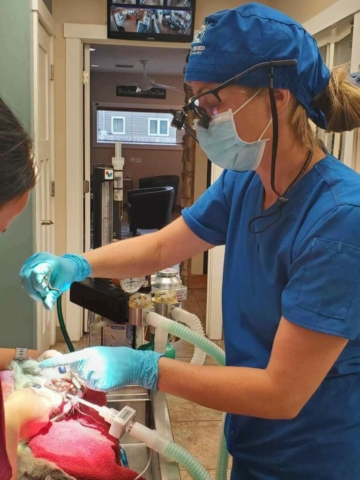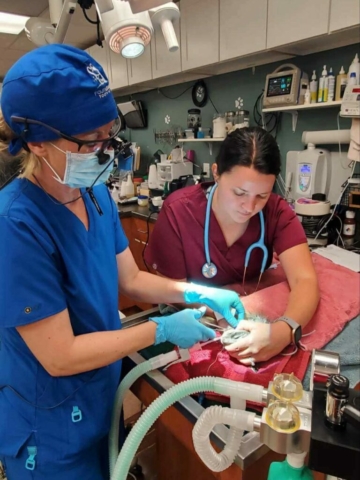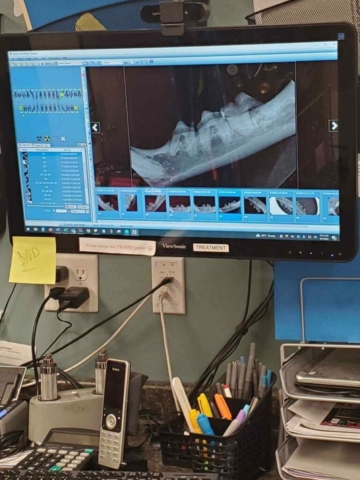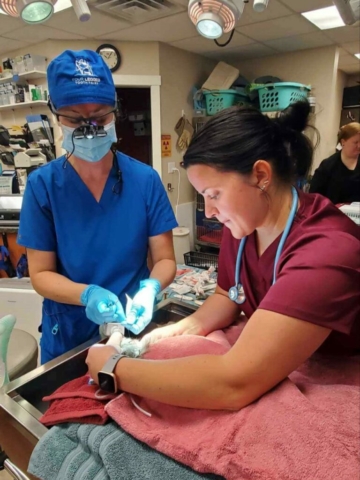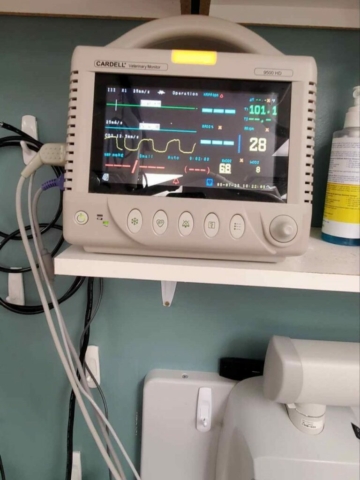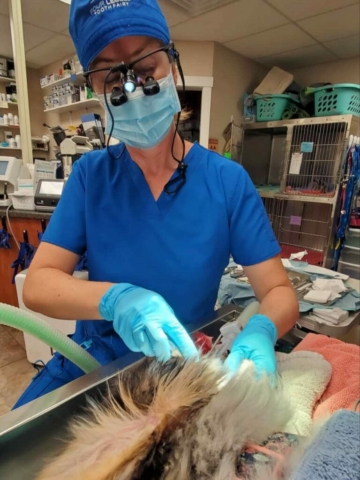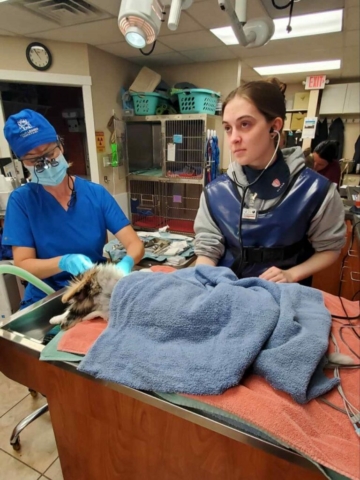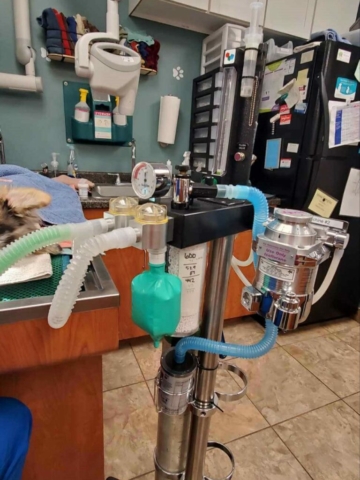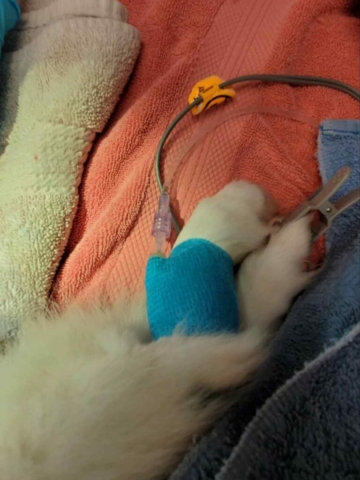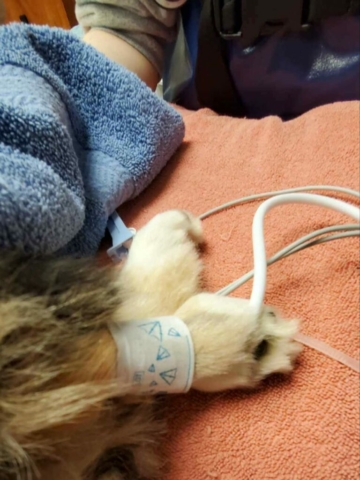What is a Staged Dental Procedure?
In the past, the veterinary industry’s approach to dental procedures for our furry patients involved a single lengthy anesthetic session, the duration of which remained unpredictable until the patient was under anesthesia. Only after the patient was anesthetized and radiographs were obtained were we able to determine what oral or dental problems we needed to resolve in that same visit. This procedure could span anywhere from 1 to 4+ hours depending upon what was found. The staged approach follows much more closely to your human dentist allowing for much more predictable treatment and time estimates as to what will be expected. These protocol changes mitigate the anesthesia risks by dividing the process into two shorter, safer, and more predictable stages.
Stage 1
- Full Ultrasonic Dental scaling and polish
- Full charting of periodontal status and progression
- Comprehensive oral examination evaluating for any oral masses, improper alignment of bite causing trauma to other teeth or soft tissues, symmetry abnormalities, and airway obstructions.
- Full-mouth Radiographs (X-rays) look for disease under the crown of the tooth. With the exception of crown fractures, most dental diseases can only be seen via radiographs.
- Potentially performing simple extractions and biopsies (if minor enough not to exceed approximately 20 minutes)
- Post cleaning Laser treatment was performed on the gingiva (gums) to decrease inflammation after ultrasonic scaling and deep pocket cleaning.
- Before and After photos of the mouth
Stage 2
- Repeat Dental Radiographs of the teeth planned for extraction (at no additional charge) to look for any new changes.
- Nerve/Pain local blocks are performed to allow for the most pain control during surgery and allow us to keep the gas anesthesia lower for decreased complications. These nerve blocks will last 4-6 hours and allow your pet to wake up from anesthesia smoothly and with minimal pain.
- Oral surgery
- Surgical Tooth extraction(s)
- Post-operative Laser treatments are performed at the surgical sites to decrease inflammation.
- Updated medical charting indicating the extractions performed.
- Before and After Photos of the Surgical Sites.
- Post-operative pain management assessment is evaluated from immediately post-op until discharge to help prevent as much pain as possible for your pet.
- Written and Video Dismissal instructions to help the pet owner feel confident in how to care for their pet after discharge.
Frequently Asked Questions
Why is the procedure divided into two stages?
Our primary aim is to enhance the safety of the process. Splitting the procedure into two stages reduces the chances of complications related to prolonged anesthesia, such as low blood pressure and low body temperature. Two shorter procedures increase the odds of smoother and quicker recoveries from anesthesia. Numerous studies for veterinary medicine indicate the complicated rates significantly increase as the patient starts to exceed 2 hours under general anesthesia.
Additionally, this approach provides cost predictability and allows for more accurate estimates for your pet’s treatment. For example, an initial treatment estimate for cleaning alone may have been in your budget when being admitted the morning of the dental procedure. However, if fractured or abscessed teeth are found after x-rays are performed, the treatment estimate to correct these conditions will significantly increase the costs you expect to pay at discharge that day. Staged procedures allow our team to get you accurate treatment estimates, discuss payment plans, and even allow the option of referral to a dental specialist for more complicated or high-risk procedures.
Finally, staged dental procedures allow our veterinary team to have a more predictable surgery flow and know how many procedures can safely be scheduled in the time allotted. When unplanned dental procedures consistently place the team behind in schedule, it increases the risk of mental and physical fatigue putting your and other pets at risk for our team being rushed and/or not having the number of staff we had planned to be available for the procedures.
How does this affect the cost of the treatment?
In short, staged procedures only affect cost minimally. Our pricing is designed to ensure that the total expense remains comparable to a one-appointment procedure.
- There is no need to repeat any pre-anesthetic testing such as bloodwork, ECG, or heart stretch testing as long as the 2nd stage is completed within the required 60 days from the 1st
- The second procedure has 50% of services such as the IV catheter, the premedication, and other anesthetic items that would have been the same if all treatments were done during the cleaning stage.
- The repeat pre and post-operative radiographs are at no additional charge.
- The extractions, oral surgery, additional anesthesia, nerve blocks, etc. would be the same charges as if all were done during the cleaning visit.
Is it safe for my pet to undergo multiple anesthetics?
If your pet can handle one anesthesia, there’s no cause for concern about a second one. Our anesthetic protocols are customized for each pet’s specific health needs, and they are closely monitored by certified veterinary technicians and specialized equipment to minimize risk.
What happens next?
Some patients will be asked to recheck specific blood and/or urine tests 1-3 months postoperatively that were elevated prior to their infected teeth being treated. This will allow us to evaluate if the blood values are corrected by removing the infection/disease.
Maintaining your pet’s dental health at home is crucial. Options include dental chews, daily brushing, oral rinses, special diets, and other recommendations based on what disease conditions were found. We will continue to evaluate your pet’s dental health during annual wellness examinations.
Dental procedures address current issues but cannot prevent future dental diseases. Many pets (especially smaller breeds due to crowded teeth) are more prone to dental problems, requiring annual procedures in order to maintain their oral health.


